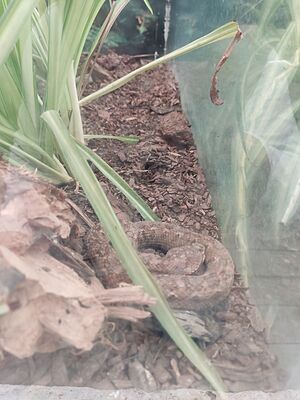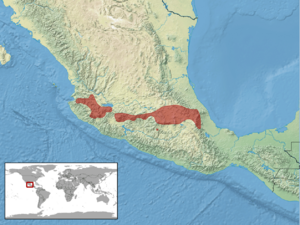Crotalus triseriatus facts for kids
Quick facts for kids Crotalus triseriatus |
|
|---|---|
 |
|
| A Mexican dusky rattlesnake at Morelia Zoo | |
| Conservation status | |
| Scientific classification | |
| Genus: |
Crotalus
|
| Species: |
triseriatus
|
 |
|
The Crotalus triseriatus is a type of venomous pit viper found in Mexico. It's also known by its common names: the Mexican dusky rattlesnake or just dusky rattlesnake. This snake species has two main types, called subspecies, that scientists currently recognize.
Contents
What Does It Look Like?
Adult male C. triseriatus snakes usually grow to be more than 60 cm (24 in) long, including their tail. Female snakes are a bit smaller. The longest one ever recorded was 68.3 cm (26.9 in) long.
Where Does It Live?
This snake species lives in Mexico. You can find it along the southern edge of the Mexican Plateau. It lives in the high mountain areas of the Transverse Volcanic Cordillera. This includes states like Jalisco, México, Michoacán, Morelos, Nayarit, Puebla, Tlaxcala, and Veracruz.
What Kind of Home Does It Like?
The Mexican dusky rattlesnake lives in several different types of environments. It can be found in pine-oak forests, boreal forests, and coniferous forests. It also lives in bunchgrass grasslands.
On Volcán Orizaba, a very tall mountain, these snakes live at extremely high altitudes. They can be found where green plants grow, even near the snow line. However, they are most common at elevations between 2,700 to 3,350 metres (8,860 to 10,990 ft).
Is It Endangered?
The Crotalus triseriatus is listed as "Least Concern" on the IUCN Red List of Threatened Species. This means that scientists believe it is not currently at risk of disappearing. Species get this rating if they are spread out widely, have a large population, or are not declining quickly. In 2007, its population was considered stable.
What Does It Eat?
Scientists have looked at the stomachs of C. triseriatus snakes to see what they eat. They found that these snakes eat a variety of small animals. Their diet includes frogs, murid rodents (like the Neotomodon alstoni), lizards, other small mammals, crickets, and salamanders.
About Its Venom
If a C. triseriatus snake bites someone, the symptoms reported include strong pain and swelling. People might also feel faint and experience cold sweat.
Different Types of This Snake
There are two main types, or subspecies, of the Mexican dusky rattlesnake:
| Subspecies | Scientist Who Named It | Common Name | Where It Lives |
|---|---|---|---|
| C. t. armstrongi | Campbell, 1979 | Western dusky rattlesnake | Mexico: Jalisco and Nayarit |
| C. t. triseriatus | (Wagler, 1830) | Dusky rattlesnake | Mexico: Michoacán, Morelos, México, Puebla, Tlaxcala and Veracruz |
How It Got Its Name
The subspecific name, armstrongi, was given to honor an American scientist who studied reptiles, Barry L. Armstrong.


